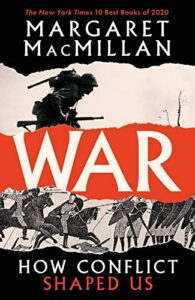 Margaret MacMillan
Margaret MacMillan
War: How Conflict Shaped Us
To make sense of our past we need to study war. So argues Margaret MacMillan in this book based on her 2018 Reith Lectures. Some are repelled while others are fascinated by war. Countless wars – between and within states – continue to shape every aspect of our lives, spanning economics, science, medicine and culture, gender roles and our general world view.
Many of us have family members who either took part in or experienced war. There are museums dedicated to telling the stories of war, and we pause to remember the causalities of war each November. MacMillan had two grandfathers who were First World War doctors and her father and uncles all served in the Second World War.
The study is thematic, looking at a different topic in each chapter. But if there is a thread that runs through the book it is the role of, and impact on, women across different contexts. It considers women as warriors, giving examples across time and cultures (including Russia’s female fighter pilots in the Second World War).
The nature of war has evolved over the centuries and continues to change; we have a much greater capacity to destroy. War is organised violence and has stimulated further organisation of society, such as nation states. The difference between fighters and civilians has blurred in recent times as non-state actors have taken on powerful armies. Equally, fighters on the front line rely on the countless efforts of civilians to equip them to do their job.
Knowing that war is so terrible, it might be suggested that the human race could learn to resolve disputes by other means. In a chapter on the reasons for war there are many examples of the causes, from territorial to ideological. Civil war is perhaps hardest to understand. Until, that is, you hear about the ethnic tensions or historical grievances that just need a spark to set alight armed violence.
Humanity has attempted to control what is largely uncontrollable through the creation of international law and humanitarian organisations that seek to help those caught up in war. Despite such efforts the brutality of war creates conditions in which violence can be indiscriminate. In contrast there is an illuminating final chapter on how art has both been used and influenced by conflict. There are a number of colour pictures showing various artistic interpretations of war.
This is wide ranging study that takes a western perspective and concentrates on examples from the post eighteenth century period. I found it a puzzling read – within each chapter the multiple examples are woven together from many threads, sometimes over a wide time span. There are some great insights such as the fact that war inverts natural order and morality – so it becomes right to blow up buildings, bridges, infrastructure and people. Fields in France after the First World War did not produce new life but death and harvests of ordinance.
In concluding, MacMillan is perhaps at her most insightful. Factors that produce war – greed, fear, ideology – remain with us and the impact of climate change will create new forms of dispute. She identifies the trend for two levels in war. One, professional military forces using high technology and the power of advanced economies. The second, loosely organised forces (largely non-state actors) using low-cost weapons. These levels overlap and it is not always the strongest forces that win the day. Terrorists recruited over the internet using knives or a car as a weapon are hard to defend against in any conventional military way.
The argument is that we need to pay attention to war because it is a reality of our world. With the growing use of artificial intelligence, automated weapons and cyberwar we face the prospect of even greater destruction. ‘It is’, as MacMillan writes in her final paragraph, ‘not the time to avert our eyes from something we may find abhorrent. We must, more than ever, think about war.’ We need to think about its causes, impact, how to end war and how to avoid it in the first place. This book certainly helps us do just that.
Review by Canon Dr Mike D Williams